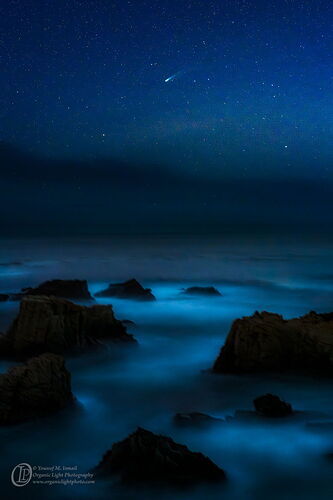Critique Style Requested: Standard
The photographer is looking for generalized feedback about the aesthetic and technical qualities of their image.
Description
I knew about the C/2025 A6 Lemmon comet but I just did not have the desire to go out and photograph it until a friend of mine contacted me and asked where he could go without any light pollution to the northwest. I asked him what he was after and he mentioned this comet as he wanted to try and photograph it using his Seestar telescope. I asked if he wanted some company and a day later we are scouting composition locations along the Big Sur coast. We settled on Garrapata Beach and then spent a good couple of hours wandering the area looking for the best view. We settled on the above.
I wanted an environmental composition rather than just a close up of the comet itself. But I also did not want a ultra wide angle where the comet might only show up the size of a star, so I gambled and went with a 50 mm lens hoping that its tail would be long enough to be a good element in the photo. I tired to photograph the sea stacks before it got completely dark with the intention of blending them into the night time exposures, but in the end I did not use them for two reasons. One they water was to bright overall and the sea stacks were dark to begin with and it made no sense trying to blend in really bright water areas, with already silhouetted sea stacks, and second, my initial composition did not include the comet in the sky as I was pointed to low. So I had to raise the view for more sky and once I did that I could not easily blend in the brighter frames anyway. So I went with just the darker frames.
I also had the camera on a star tracker, and realized that these darker frames would have blurred sea stacks as the tracker moved, but I was not planning on using the frames that were tracked for the foreground, as they would be blurred as the camera moved but they did not.
In the end, it was only the tracked frames that worked out. The other thing that I noticed while standing on the cliffs overlooking the crashing surf was how bright the water was under the dark sky. It almost seemed like the water was glowing. When I started to process the photo, I noticed the bright tones had a heavy blue cast to them, and in hindsight I think the reason the crashing surf was so bright to my eyes was the bioluminescent bacteria must have still been in the water. So given the blue tones in the water I opted for an overall blue hue for the whole scene. Finally the dark band that separates the water from the sky was a thick fog bank that just hovered off shore ever threatening to move over us and block the sky. Luckily it did not, but eventually as the night progressed and the sky sank into the west, the comet did drop behind the fog bank and we called it a night.
Specific Feedback
My main concern is the overall blue hue to the whole scene. How unnatural does it look?
Second, is the comet prominent enough in the scene, I mean it was what I was after?
Technical Details
Nikon D850, Nikon 50 mm f/1.8 MF lens, set at f5.6 and 1 min exposure, ISO 3200
Taken about 1.5 hours after sunset
Processed in ACR and PS with quite a few layers using TK masks to bring everything together in this single frame and trying to get an even tonality and hue in the sky that matched the hue in the water. I have about 6 frame variations made over the about 2.5 hours, some earlier than this frame and some later, but this one had the best water action and comet placement. The earlier frames had more hues in the sky that were remnants of sunset during nautical twilight. The later ones had the comet to close to the fog bank. The brightness of the sky on the right was coming from Monterey and Carmel about 8 to 12 miles further up the coast from where we were.
Critique Template
Use of the template is optional, but it can help spark ideas.
Vision and Purpose:
Conceptual:
Emotional Impact and Mood:
Composition:
Balance and Visual Weight:
Depth and Dimension:
Color:
Lighting:
Processing:
Technical:
